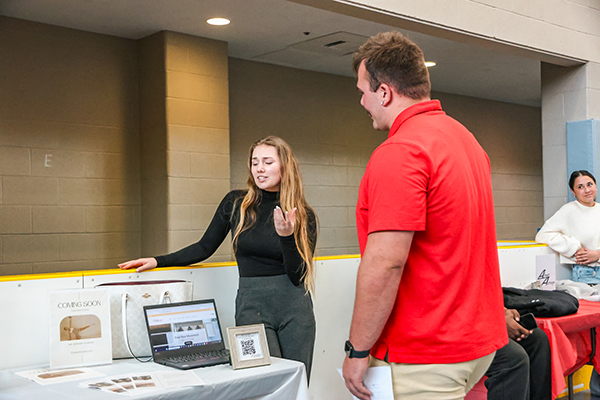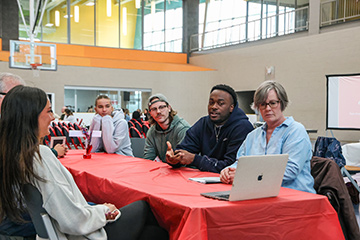
06/10/2025
In a competitive business world where even a small advantage can be the difference between a flop and the Fortune 500, you can never be too prepared. The return of SUNY Cortland’s Innovation Day aimed to give its entrepreneurial students that leg up.
The events let participants hear business pitches from students in the Entrepreneurship 1 course taught by James Wilson, lecturer in the Economics Department, and, for the first time, learn about products created in the Community Innovation Lab course taught by Kathleen Burke, distinguished teaching professor in the Economics Department.
Innovation Day grew out of final business pitches given in an entrepreneurship class, according to Burke. Once done as an internal function of the department, she described this year as a re-envisioning of the event to make it more community oriented.
“We broadened the scope of the event, combining both the Entrepreneurship 1 pitches with the Community Innovation Lab presentation of final products to our community partners,” Burke said. “Additionally, we featured eight student-run businesses between the scheduled class activities.”
She noted that one of those businesses, called Wisdom Wings, was created by student Elizabeth Verboys and provides care baskets to abused children by sending them to police stations.

The Entrepreneurship 1 pitches were judged by faculty and outside business owners and entrepreneurs with NIL Finder taking first place. It was the same team that placed in the top six in the recent New York Business Plan Competition and took home $10,000 against the likes of eventual winner Columbia University, Clarkson University, Cornell University, Skidmore College and Binghamton University, one of SUNY’s four big research universities.
This year's judges for the Entrepreneurship 1 pitches were Thomas Garden, a 1981 alum and donor to the SUNY Cortland Entrepreneurship Center, Johanna Ames, Cortland College Foundation board member, Eddy Jurnasin, SUNY Cortland assistant professor of economics, and Burke.
The newly featured Community Innovation Lab class got to show off the products it created in partnership with local businesses and nonprofits.
“They work hand-in-hand with the businesses to complete a project,” said Burke. “Anywhere from social media content marketing to business models and inventory apps, this project-based course gives students real-life experience using the skills learned in the classroom to help the members of the Cortland business community.”
One of those products was for Cortland ReUse, a thrift store. Students created computer code for a new inventory system that created a database of donated products and calculated the environmental impact of reusing those items instead of sending them to a landfill. That data can in turn be used to apply for grants and other funding.
Another that Burke noted was a student-made annual report template for the Cortland Community Foundation, run by Tom Gallagher, chair of the University’s College Council. The new template helps the foundation highlight how their grants assist the local area.
The Economics Department’s efforts to build up the next generation of business owners didn’t stop at Innovation Day. A recently announced entrepreneurship minor coincides with the school’s upcoming SUNY Cortland Entrepreneurship Center, located on Main Street in the city of Cortland. It will bring students downtown to give them real experience with businesses away from campus. Its opening is scheduled for the 2025-26 academic year.
Both Entrepreneurship 1 and Community Innovation Lab courses are part of the minor. Participating students will be qualified to apply to be an intern at the center to help s develop community and student start-up ideas while supporting local businesses and nonprofit organizations.
Additionally, Burke was able to gain a Business-Higher Education Fellowship to create Cortland’s Business Assistance Internship Program, which will use the developing skills of its students to help local businesses meet some critical needs that could include marketing, technical writing and design.
Innovation Day is expected to return next year, and will continue to be a platform to showcase the ideas growing out of Cortland’s classrooms.